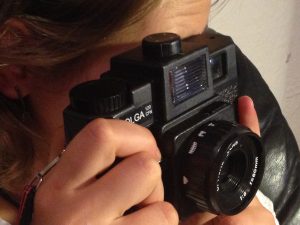“Old media enhances creative experience”
When coming up with the statement “old media enhances creative experience”, I was coming from a place of not having dabbled extensively in creative mediums that would fall under the banner of ‘old media’. I came up with the statement simply as an observation of how mediums such as photography, film and audio seem to be more engaging when old technologies are employed.
I decided to take a series of photos as a response to the statement. I remembered that my girlfriend had purchased a Holga camera a couple of years ago, and it occurred to me that the Holga camera gives the photographer a very different, perhaps more engaging creative experience. This is partly because the only indication of the success of the photo is given from looking through the camera, not displayed on a screen as with most digital cameras. Also, the limited number of photos in the film canister forces you to take care with each image. For this reason, I decided to experiment with putting my phone camera up to the Holga and capture images through the ‘eye’ of the camera. The resultant images give the perspective of the person using the camera, which I believe conveys a sense of intimacy and connection to the creative experience.
A strength of Analogue photography is the creation of images which are actual, tactile objects. The addition of the material object adds satisfaction to the creative experience. The images depicted in one of the 4 photos were taken with that Holga, and highlight the material gain that is associated with analogue photography. Breitbach argues that despite the apparent demise of analogue photography in the 21st century, “the medium of photography once again asserts its mythical ties with the elusive Real” (Breitbach, 2011). It seems that the materiality associated with analogue photography, and old media in general, helps it continue to thrive.
One of the potential drawbacks of old media is that generally old media formats are slower than new technologies. However, Knowles argues that the slowness of old media is not a drawback. On the contrary, she argues that “slow (analogue) cinema can be seen as part of a wider ethics of embodied interconnectedness… of physical engagement and being in the world” (Knowles, 2016). This also applies to old photography techniques, which are undeniably slower and more methodical than digital photography. I believe that this slowness allows the photographer to engage on a deeper level with their images and therefore, the creative experience is enhanced.
This is not to say that digital photography is inherently worse than analogue. As Biro points out, “because the camera always selects – or edits – and otherwise changes the world that exists before its lens, no photograph – analogue or digital – can be said to represent the complete ‘truth’” (Biro, 2012). I’m also aware of the irony of taking digital photos through the lens of an analogue camera. I do maintain, however, that the experience of photography is enhanced through the use of analogue materials, both through the materiality of the photos and the connection to the process. This connection is what I was trying to convey in my 4 images.
Works Cited:
Biro, M. (2012). From Analogue to Digital Photography: Bernd and Hilla Becher and Andreas Gursky. History of Photography, 36(3), pp.353-366.
Breitbach, J. (2011). The Photo-as-thing. European Journal of English Studies, 15(1), pp.31-43.
Knowles, K. (2016). Slow, Methodical, and Mulled Over: Analog Film Practice in the Age of the Digital. Cinema Journal, 55(2), pp.146-151.




Leave a Reply